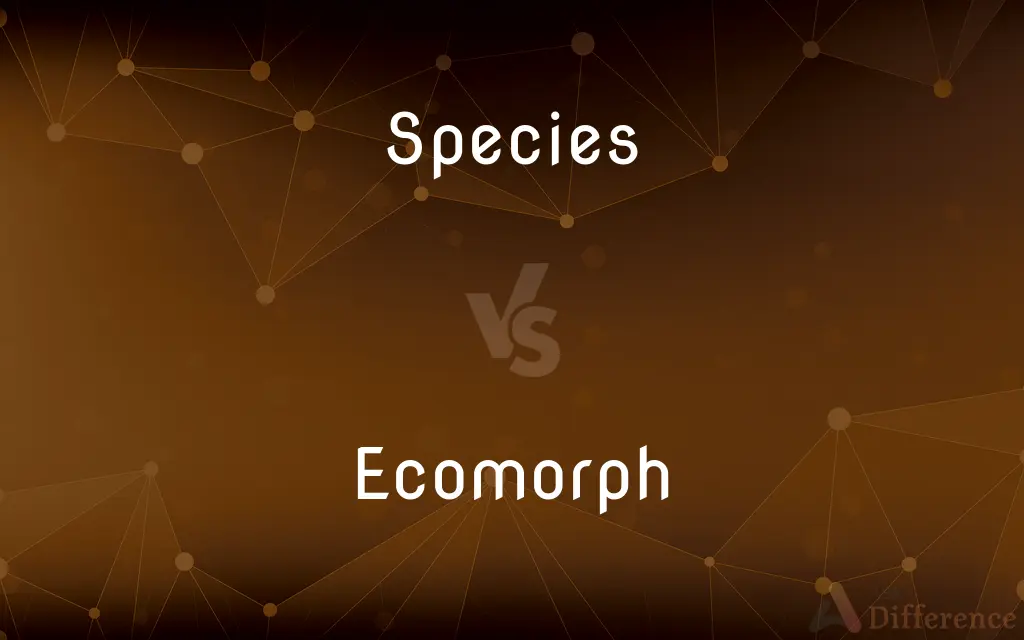Species vs. Ecomorph — What's the Difference?
By Tayyaba Rehman & Maham Liaqat — Updated on March 7, 2024
Species are distinct biological groups capable of interbreeding, while ecomorphs are variations within species adapted to specific environments.

Difference Between Species and Ecomorph
Table of Contents
ADVERTISEMENT
Key Differences
Species represent a fundamental category in biological classification, defined by the ability of individuals to interbreed and produce fertile offspring. On the other hand, ecomorphs refer to distinct forms or morphologies within a species that have adapted to specific environmental conditions.
While species are identified based on genetic makeup and reproductive compatibility, ecomorphs are recognized by physical characteristics and ecological roles. The study of ecomorphs can provide insights into the mechanisms of natural selection and the evolutionary processes that shape biodiversity.
The concept of species is central to the study of evolutionary biology, conservation, and taxonomy. Ecomorphology, on the other hand, focuses on the relationship between an organism's physical form and its ecological function.
Protecting species from extinction is a key concern in conservation efforts, as each species plays a unique role in its ecosystem. Studying ecomorphs can reveal how different environmental pressures lead to variations within a species, which can inform conservation strategies by highlighting the importance of preserving diverse habitats to support the full range of ecological adaptations within a species.
Comparison Chart
Definition
A group of living organisms capable of interbreeding to produce fertile offspring.
A variation within a species adapted to a specific environment.
ADVERTISEMENT
Basis of Distinction
Reproductive isolation and genetic makeup.
Physical adaptations and ecological niches.
Significance
Fundamental unit in biological classification and biodiversity.
Shows how organisms adapt to different ecological conditions within the same species.
Study Focus
Evolutionary relationships, conservation, and taxonomy.
Relationship between physical form and ecological function.
Conservation Implication
Emphasizes the protection of species to preserve genetic diversity and ecosystems.
Highlights the importance of diverse habitats to support different adaptations within a species.
Compare with Definitions
Species
A group of individuals that can interbreed and produce fertile offspring.
Humans (Homo sapiens) are considered a single species because they can interbreed and produce fertile offspring worldwide.
Ecomorph
Variants within a species adapted to specific habitats.
The Anolis lizards in the Caribbean have developed different ecomorphs to adapt to life in the trees or on the ground.
Species
Defined by its unique position on the evolutionary tree, reflecting its evolutionary history.
The red wolf is considered a distinct species based on its unique phylogenetic lineage.
Ecomorph
Adaptations to different climatic conditions within the same species.
The snowshoe hare has ecomorphs with different fur colorations adapted to seasonal changes in their environment.
Species
Defined by distinct genetic makeup that differentiates it from other species.
The genetic differences between chimpanzees (Pan troglodytes) and bonobos (Pan paniscus) classify them as separate species.
Ecomorph
Shows adaptations related to different feeding strategies within the same species.
Cichlid fish in African lakes have various ecomorphs specialized for different types of feeding, such as scraping algae or eating other fish.
Species
A group of organisms adapted to a particular ecological niche.
The Galápagos finches are different species based on their ecological niches and feeding habits.
Ecomorph
Physical differences that correspond to different ecological roles.
Darwin’s finches have developed beak sizes and shapes that are ecomorphs adapted to their specific feeding habits.
Species
Identified by physical characteristics that distinguish it from other species.
The African elephant and the Asian elephant are considered different species due to distinct morphological features.
Ecomorph
Distinctive behaviors that allow survival in specific environmental conditions.
Some ecomorphs of the same species of spider might build different types of webs suited to catching different kinds of prey.
Species
A group of living organisms consisting of similar individuals capable of exchanging genes or interbreeding. The species is the principal natural taxonomic unit, ranking below a genus and denoted by a Latin binomial, e.g. Homo sapiens.
Ecomorph
Within a species: a population which has distinctive ecological and morphological features; a member of such a population.
Species
A kind or sort
A species of invective at once tough and suave
Ecomorph
An ecological and morphological type, especially a form whose convergence with that of another organism or organisms (which may belong to different populations, taxa, etc.) is the result of adaptation to similar habitats rather than common descent.
Species
The visible form of each of the elements of consecrated bread and wine in the Eucharist.
Ecomorph
A local variety of a species whose appearance is determined by its ecological environment.
Species
(Biology) A group of closely related organisms that are very similar to each other and are usually capable of interbreeding and producing fertile offspring. The species is the fundamental category of taxonomic classification, ranking below a genus or subgenus. Species names are represented in binomial nomenclature by an uncapitalized Latin adjective or noun following a capitalized genus name, as in Ananas comosus, the pineapple, and Equus caballus, the horse.
Species
(Logic) A class of individuals or objects grouped by virtue of their common attributes and assigned a common name; a division subordinate to a genus.
Species
(Chemistry) A set of atoms, molecules, ions, or other chemical entities that possess the same distinct characteristics with respect to a chemical process or measurement.
Species
A kind, variety, or type
"No species of performing artist is as self-critical as a dancer" (Susan Sontag).
Species
The outward appearance or form of the Eucharistic elements that is retained after their consecration.
Species
Either of the consecrated elements of the Eucharist.
Species
Type or kind. race.}}
The male species
A new species of war
Species
A group of plants or animals having similar appearance.
This species of animal is unique to the area.
Species
A category in the classification of organisms, ranking below genus; a taxon at that rank.
Species
A particular type of atom, molecule, ion or other particle.
Species
(mineralogy) A mineral with a unique chemical formula whose crystals belong to a unique crystallographic system.
Species
An image, an appearance, a spectacle.
Species
(obsolete) The image of something cast on a surface, or reflected from a surface, or refracted through a lens or telescope; a reflection.
I cast the species of the Sun onto a sheet of paper through a telescope.
Species
Visible or perceptible presentation; appearance; something perceived.
Species
(Christianity) Either of the two elements of the Eucharist after they have been consecrated.
Species
Coin, or coined silver, gold, or other metal, used as a circulating medium; specie.
Species
A component part of compound medicine; a simple.
Species
Plural of specie
Species
Visible or sensible presentation; appearance; a sensible percept received by the imagination; an image.
Wit, . . . the faculty of imagination in the writer, which searches over all the memory for the species or ideas of those things which it designs to represent.
Species
A group of individuals agreeing in common attributes, and designated by a common name; a conception subordinated to another conception, called a genus, or generic conception, from which it differs in containing or comprehending more attributes, and extending to fewer individuals. Thus, man is a species, under animal as a genus; and man, in its turn, may be regarded as a genus with respect to European, American, or the like, as species.
Species
In science, a more or less permanent group of existing things or beings, associated according to attributes, or properties determined by scientific observation.
Species
A sort; a kind; a variety; as, a species of low cunning; a species of generosity; a species of cloth.
Species
Coin, or coined silver, gold, or other metal, used as a circulating medium; specie.
There was, in the splendor of the Roman empire, a less quantity of current species in Europe than there is now.
Species
A public spectacle or exhibition.
Species
A component part of a compound medicine; a simple.
Species
The form or shape given to materials; fashion or shape; form; figure.
Species
(biology) taxonomic group whose members can interbreed
Species
A specific kind of something;
A species of molecule
A species of villainy
Common Curiosities
Can ecomorphs lead to new species?
Yes, over time, ecomorphs can lead to new species if the adaptations result in reproductive isolation.
Why is the concept of species important in biology?
It is essential for understanding biodiversity, evolutionary relationships, and for conservation efforts.
What role do ecomorphs play in evolution?
Ecomorphs play a crucial role in demonstrating how organisms adapt to their environment, which can lead to speciation.
How are new species identified?
New species are identified through genetic, morphological, ecological, and phylogenetic analyses.
What defines a species?
A species is defined by the ability of its members to interbreed and produce fertile offspring.
How do ecomorphs arise within a species?
Ecomorphs arise through adaptations to specific environmental conditions, leading to physical and behavioral variations within a species.
How do ecomorphs contribute to biodiversity?
Ecomorphs contribute to biodiversity by showcasing the adaptive variations within species to different ecological niches.
What is the main difference between species and ecomorphs?
The main difference is that species are defined by reproductive capabilities, while ecomorphs are defined by adaptations to the environment.
Can humans be considered to have ecomorphs?
While humans have adapted culturally and physically to various environments, the term ecomorph is typically used in the context of non-human species.
Is genetic diversity important for species survival?
Yes, genetic diversity is crucial for species' adaptability to changing environments and for long-term survival.
Can ecomorphs interbreed within the same species?
Yes, ecomorphs within the same species can typically interbreed.
How does habitat affect the development of ecomorphs?
The habitat imposes specific environmental pressures that drive the development of adaptations, leading to ecomorphs.
What is an example of a morphological species concept?
The morphological species concept identifies species based on distinct physical features, such as the different shapes of bird beaks.
Share Your Discovery

Previous Comparison
Principle vs. Theory
Next Comparison
Assignment vs. AssessmentAuthor Spotlight
Written by
Tayyaba RehmanTayyaba Rehman is a distinguished writer, currently serving as a primary contributor to askdifference.com. As a researcher in semantics and etymology, Tayyaba's passion for the complexity of languages and their distinctions has found a perfect home on the platform. Tayyaba delves into the intricacies of language, distinguishing between commonly confused words and phrases, thereby providing clarity for readers worldwide.
Co-written by
Maham Liaqat















































